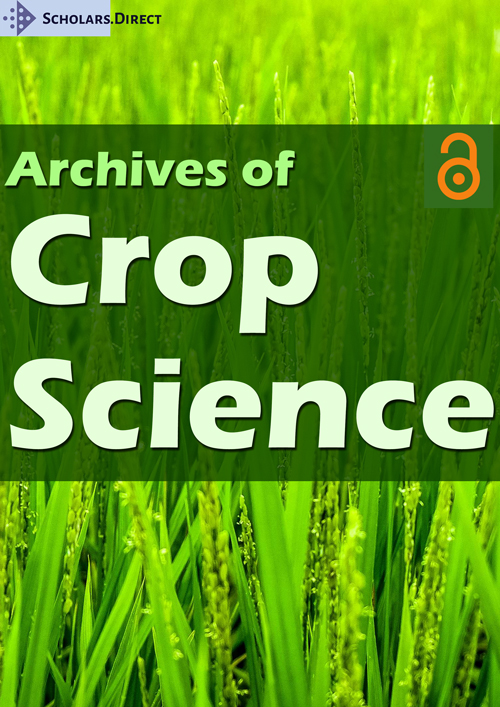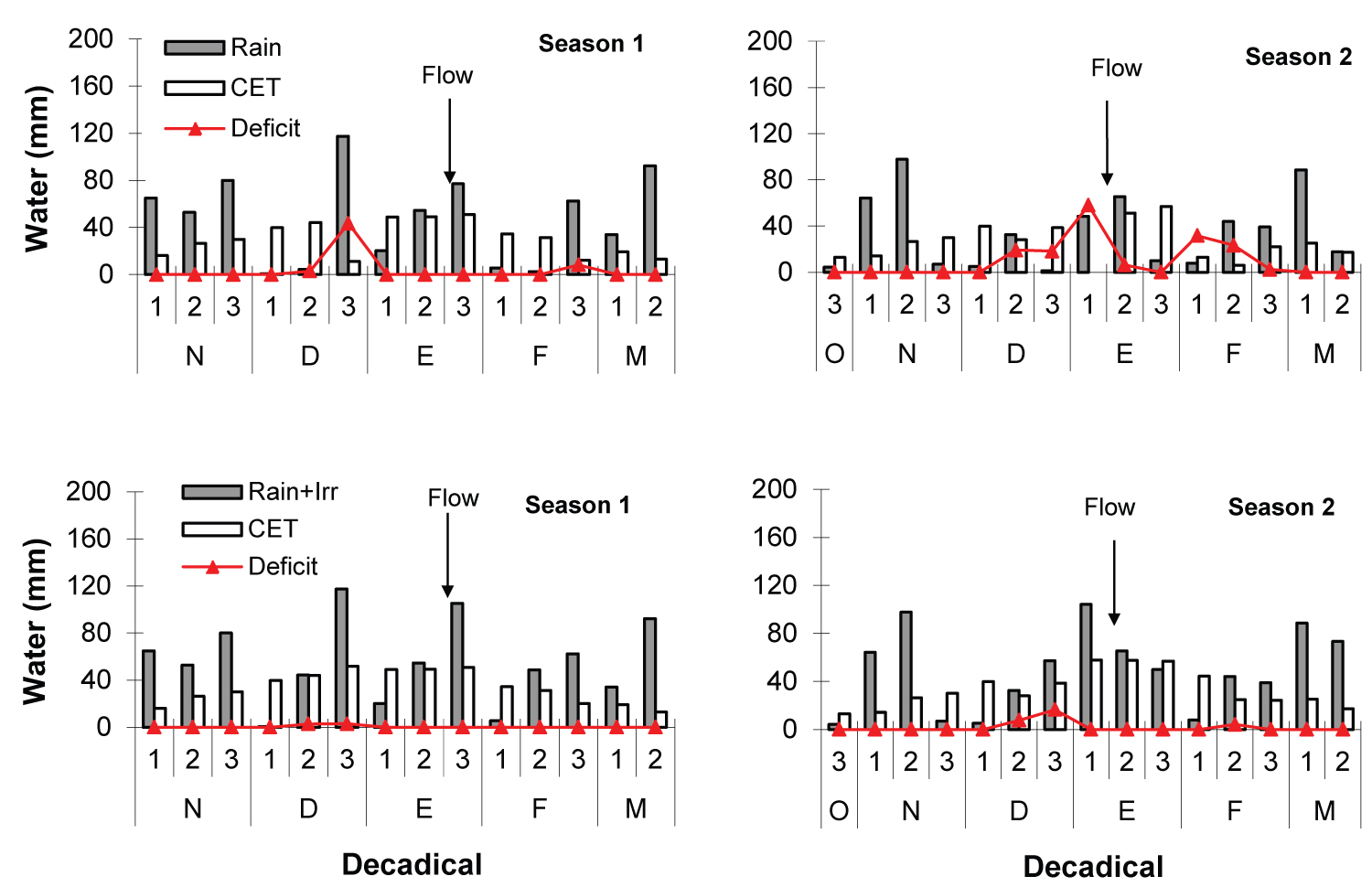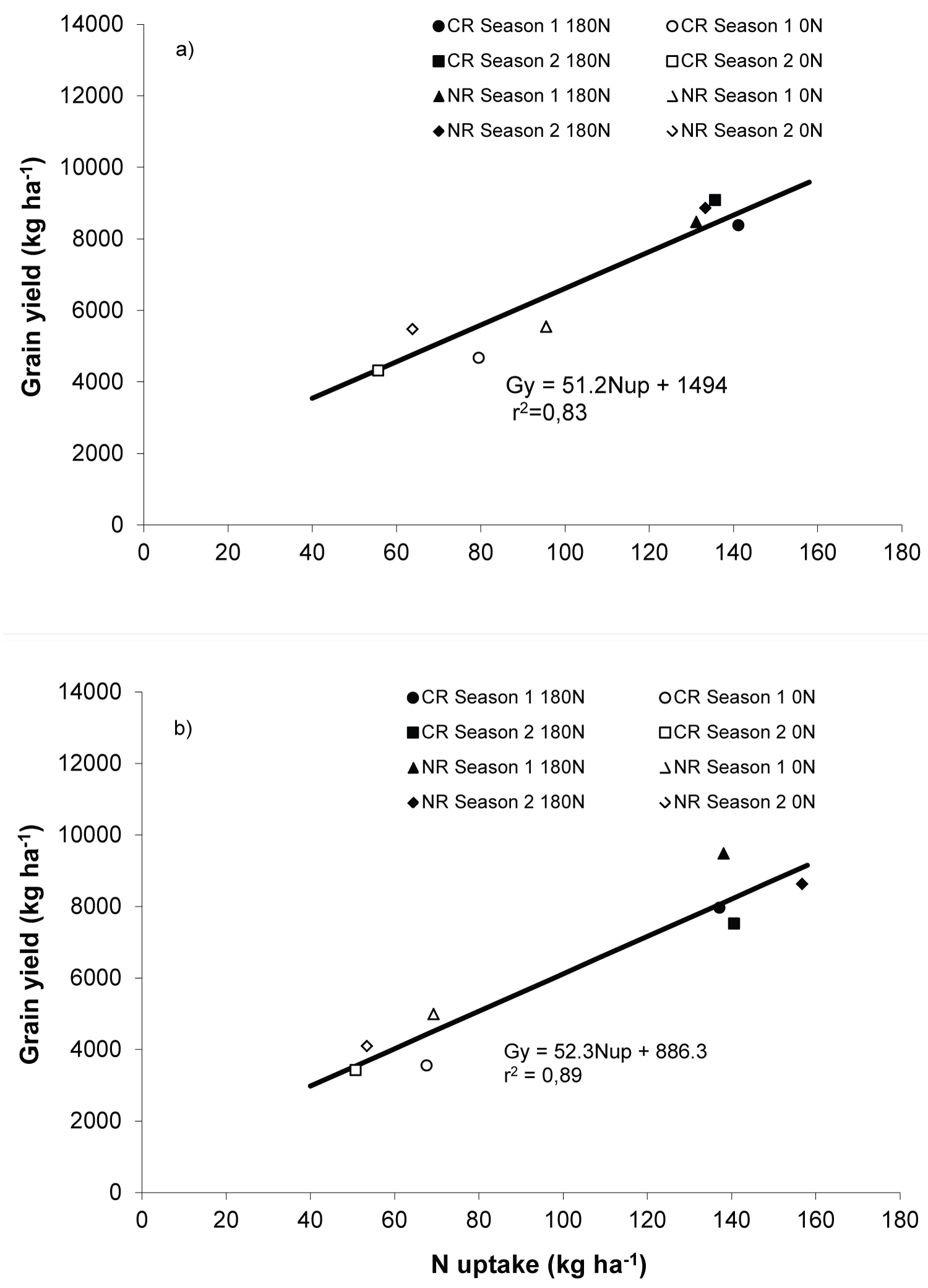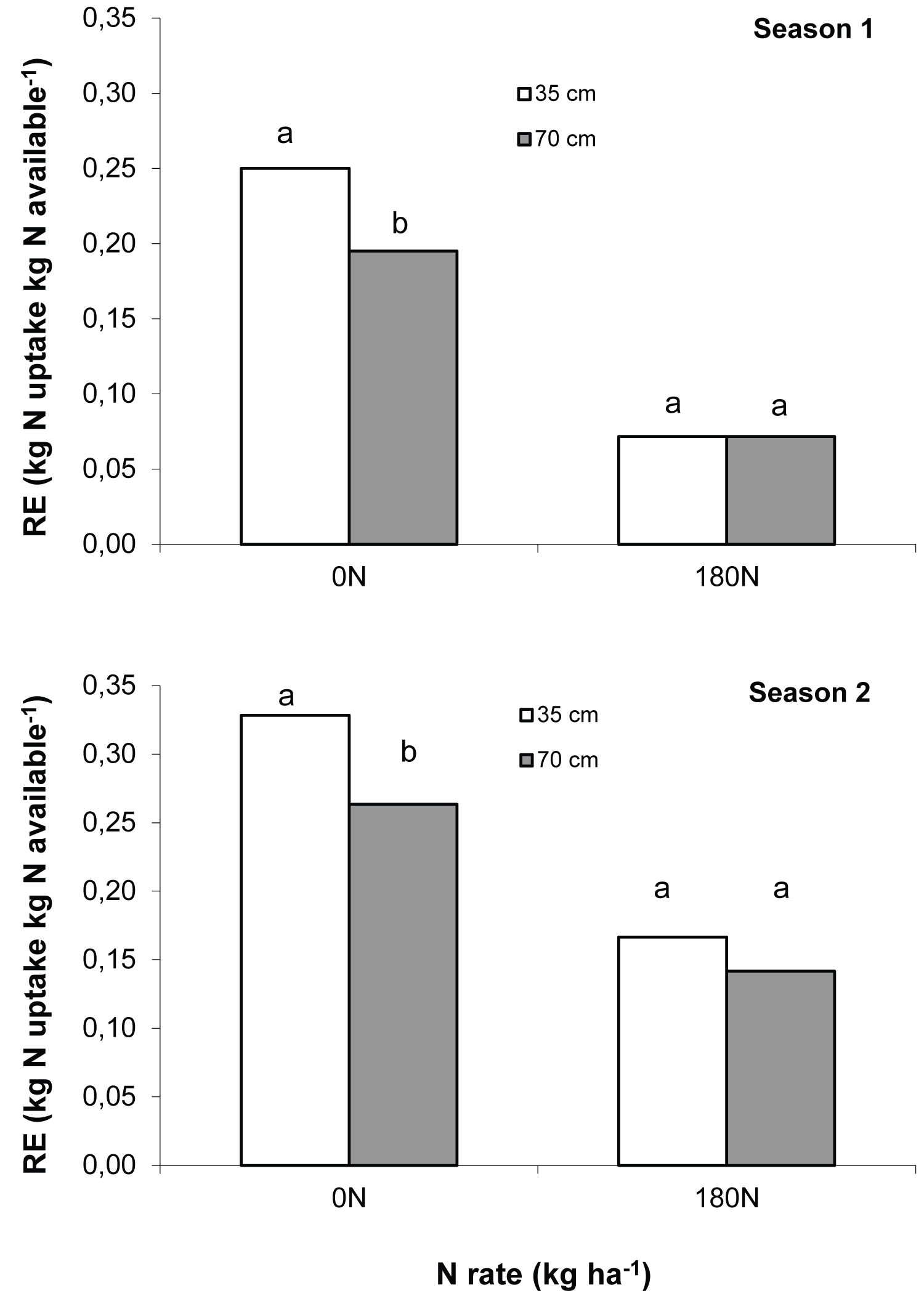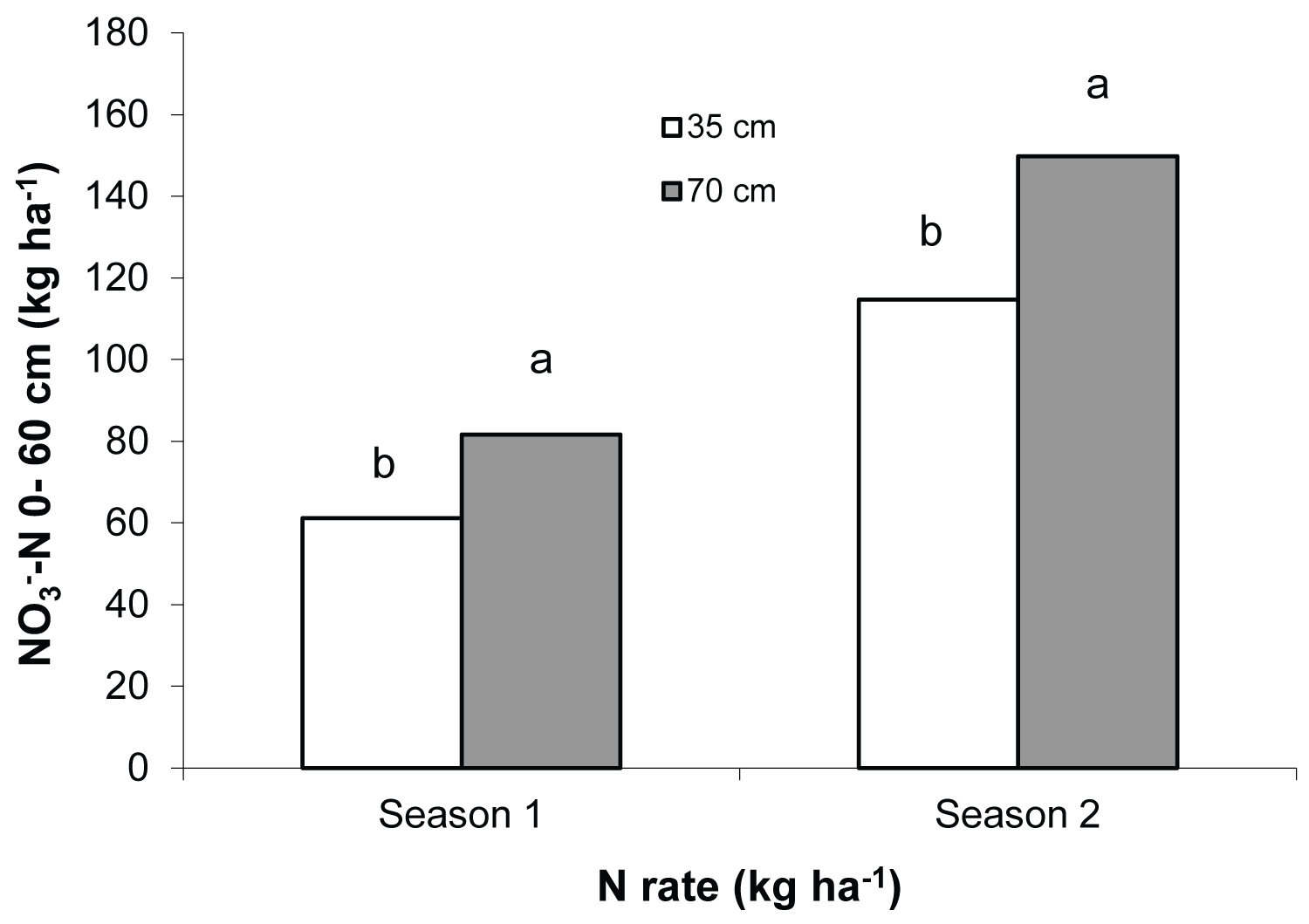Water Availability and Row Spacing Effects on Nitrogen Use Efficiency in No-Till Maize
Abstract
Reduced row spacing has shown to increase nitrogen use efficiency (NUE) in no-till irrigated maize; however available information in rainfed conditions is scarce. The objective was to analyze row spacing effects on NUE under different water and nitrogen (N) regimes. Maize crops were grown at Balcarce, Argentina, during two seasons. Treatments included two water regimes (rainfed and irrigated), two rows spacing (35 and 70 cm) and two N rates (0 and 180 kg N ha-1). Nitrogen rate and narrow rows increased total dry matter (DM), grain yield, and DM and grain N accumulation in both water regimes. In both years and water regimes, narrow rows increased NUE. Physiological efficiency decreased with N rate and was not affected by row spacing. Recovery efficiency (RE) decreased with N rate, and wide rows spacing. Narrow rows effects on RE decreased as N availability increased. Narrow rows increased NUE largely as a result of increased RE. Greater RE for narrow rows treatments was evident since early growth stages (V6). Average two growing seasons, grain yield and NUE response to narrow rows was higher for rainfed condition and/or N deficient crops than maize with high N rate and irrigation. Results shown that narrow rows increased NUE in no-till maize under rainfed conditions.
Keywords
Zea Mays L, Nitrogen fertilization, Crop management, Soil fertility
Abbreviations
DM: Dry Matter; NUE: Nitrogen Use Efficiency; PE: Physiological Efficiency; RE: Recovery Efficiency; GPN: Grain Yield Per Unit N in Grain; NGE: N in Grain Per Unit of Available N; NT: No-Till
Introduction
Water and nitrogen (N) availability remain, globally, the most limiting crop growth factor [1]. Water availability affects grain yield response and in consequence N use efficiency (NUE = DM or grain yield per unit of available N). Adequate soil moisture during crop growth and development is fundamental to obtain high NUE [2]. Water stress often leads to stomata closure, which inhibits photosynthesis and thus growth and N uptake by the plant [3,4]. However, high amounts of water, results in high variability in soil moisture conditions such as temporary saturated conditions, which are adverse for mineralization [5] and favorable for denitrification and leaching [6,7]. Maize (Zea mays L.) grown under deficit irrigation requires less N fertilizer to achieve maximum grain yield than that required with well-watered conditions [8].
Nitrogen recovery efficiency in maize ranged from 25 to 91% [9,10] depending on N source, N rate, application time and irrigation method. Low N recovery efficiency is associated with N losses from NO3--N leaching, NH3 volatilization, surface runoff and denitrification [2]. Modern production agriculture requires efficient, sustainable and environmentally sound management practices. Under this condition, increasing crop yield per unit area through use of appropriate N management practices has become essential component of crop production technology [11]. Production practices that have resulted in increased NUE relative to conventional or standard practices are those that will reduce N loss from soil-plant systems [12]. No-tillage (NT) affects soil and fertilizer N dynamics, decreasing N availability for crops due to potentially greater losses and immobilization [13]. Consequently, fertilizer N requirement of maize under NT is greater than under conventional tillage (CT) [14], and therefore, greater N rate would be added to equal yield under CT. High N fertilization has resulted in low NUE and in nitrate ground-water contamination, which not only wastes resources and energy [15] but seriously affects the agricultural and ecological environment [16,17].
NT maize is becoming a very important crop in Southeastern of Buenos Aires province (Argentine), where climate is template-humid. In this region, fertilizer-N recovery in irrigated maize under NT is higher for fertilization at the six-leaf stage (V6) than fertilization at planting time [18,19]. Nitrogen recovery by maize crop was 71 and 58% for fertilization at the V6 and at planting time, respectively [18]. This difference as consequence of significant N losses by denitrification and/or NO3--N leaching determined during the period elapsed between planting and V6, because precipitations exceed evapotranspiration demand mainly during initial stages of crop growth [20]. In spite of this, Argentinean farmers preferred generally surface broadcast urea at planting because it reduces logistical problems associated with soil sampling and N fertilization after planting. In this sense, is imperative to develop management practices to maximizing recovery of available N by crops and in consequence increased NUE, economic returns, and reduces N potential losses and therefore adverse environmental impacts.
Narrow rows (35 and 52 cm) in NT irrigated maize increased NUE expressed as dry matter (DM) or grain yield, compared to conventional row spacing (70 cm) [21]. Higher NUE in narrow rows treatments were consequence of an increases determined in recovery efficiency (RE = N uptake per unit of available N). Nevertheless, these results were obtained under irrigation conditions; in consequence, information about row spacing effects on NUE in rainfed conditions is scarce. In the southeastern of Buenos Aires province, irrigation maize is not a common management practice (less than 5% of area), therefore, is necessary determined if narrow rows affect NUE in maize under NT in the rainfed conditions. Nutrients and water uptake by plants is greatly influenced by development and morphology of the root system [22]. In situation on slightly water deficiencies, we hypothesized that narrow rows increase NUE of NT maize due to higher RE of available N (soil plus fertilizer). These results would have a great impact in product system, because could contribute to increase the profitability of maize production and diminish risk of environmental pollution The objective of this study was to analyze row spacing effects on NUE and its components, physiological efficiency (PE) and RE in NT maize under different water and N availability.
Materials and Methods
The experiments were carried out during two growing seasons at the Instituto Nacional de Tecnología Agropecuaria (INTA) Research Station, Balcarce (37°45'S; 58° 18'W; 130 m above sea level, 870 mm mean annual rainfall, 13.7 ℃ mean annual temperature), Buenos Aires, Argentina. This area is characterized by low average temperature during the growing season and a frost free period of about 150 days. More details about climatic data were presented in Andrade and Gardiol [23]. The soil was a complex of a fine mixed Typic Argiudoll and a fine thermic Petrocalcic Paleudoll (petrocalcic horizon was below 70 cm), with a loam texture at the surface layer (0-25-cm depth), loam to clay-loam at sub-surface layers (25-110-cm depth) and sandy-loam below 110-cm depth (C-horizon). Some soil characteristics determined at planting are presented in Table 1.
The experiment was carried out on a maize monoculture under NT. Soil cover by maize residues ranged from 80 to 90%. In two growing seasons a single cross maize hybrid was used and planting during the first or second week of October. Plots were fertilized annually at planting with 20 kg P ha-1. Weeds and insects were effectively controlled. The experimental design was a split-split-plot in randomized complete blocks with three replications. Where main plot was water availability (irrigated and rainfed conditions), sub-plot was N rate (0 and 180 kg of N ha-1) and sub-sub-plot was rows spacing (70 and 35 cm between rows). The experimental units were 14-m long and seven rows wide (two border rows on each side, 68.6 and 34.3 m2 for 70 and 35 cm, respectively). In the irrigation treatments, sprinkle irrigated were applied during high-water requirements periods so that theses production factors did not limit crop growth. In both years, N fertilizer (as urea 46-0-0) was applied broadcast at planting, plant density at harvest was constant for all treatments and ranged between 7.5 and 6.4 plants m-2 in Season 1 for irrigated an rainfed conditions, respectively, while in Season 2 plant density ranged between 7.7 and 6.7 plants m-2 for irrigated an rainfed conditions, respectively.
In both growing season, soil sampling before planting was done by randomly collecting twenty 2-cm-diameter cores from each main plot. Soil samples were collected at 0- to 20-, 20- to 40-, and 40- to 60-cm depths. Inorganic N was extracted from fresh samples with K2SO4 (0.5 M) and NO3--N and NH4+-N contents were determined by microdistillation [24]. The bulk density was determined by the cylinder method [25]. In all growing seasons before planting, eight undisturbed soil cores (5-cm diam. by 5-cm length) were taken from each block. Average soil bulk density utilized was 1.25, 1.35 and 1.40 Mg m-3 for 0- to 20-, 20- to 40-, and 40- to 60-cm depths, respectively.
At V6 and R6 growth stages, 10 maize plants were collected from three interior rows to determine aboveground dry matter accumulation (DM). Plant were cut at ground level, separated into leaf blades and stalk plus sheaths at V6 and leaf blades, stalk plus sheaths plus tassel plus husks, and grain at R6. Samples were oven dried, weighed, and milled to pass a 1-mm mesh. Reduced-N was determined by Method A (without salicylic acid modification) as reported by Nelson and Sommers [26]. Total N accumulated in each fraction was calculated as the product of its N concentration (dry weight basis) and dry weight. At maturity, three 7.15 m-long interior rows of each experimental unit were hand-harvested to determine grain yield. All reported yields were corrected to 140 g kg-1 grain moisture content.
Nitrogen mineralized from organic matter during the growing season was determined using the model reported by Echeverría, et al. [27]. This model integrates the potentially mineralizable N (N0), N mineralization constant, soil temperature and soil moisture at the 20-cm depth during the growing season. The N0 was estimated by anaerobic incubations of 14 days [28]. Nitrogen mineralized estimated by the model in Season 1 were 78 and 50 kg N ha-1 for irrigated and rainfed conditions, respectively, and in Season 2 were 76 and 46 kg N ha-1 for irrigated and rainfed conditions respectively.
Soil available N (Nav) was calculated as: NO3--N at the beginning of growing season + N mineralized from organic matter during the growing season + fertilizer N input. Nitrogen use efficiency (kg kg-1 Nav) was calculated as the ratio between DM and Nav (NUEDM) and between grain yield (0% moisture) and Nav (NUEG); PE (kg kg-1 N uptake) was calculated as the ratio between DM and N uptake; RE (kg N kg-1 Nav) was calculated as the ratio between N uptake and Nav [29]. Other variables calculated were grain yield per unit N in grain (GPN) (kg N kg-1) and N in grain per unit of Nav (NGE) (kg N kg-1 Nav). Total N in aboveground DM was considered as N uptake. Data of grain yield, DM, N uptake, NUE, PE, RE, GPN, and NGE were analyzed using the corresponding error terms for each experimental design. Analysis of variance was accomplished using SAS software [30]. Treatment means were compared using the Tukey mean separation procedure [31]. When interaction between row spacing and N rate was significant, means of row spacing were compared for the same N level.
Results and Discussion
Climatic conditions
In the irrigation treatments, water availability not limited crops growth during the two growing seasons because rainfall and irrigations met and overcame the evapotranspiration demand (590 mm) calculated for the area [23], while in both growing seasons available water in rainfed treatments during grain set shown a deficit that would be affected slightly grain yield (Figure 1).
Aboveground dry matter accumulation, grain yield, nitrogen accumulation
In both growing seasons, irrigation and N fertilization increased significantly DM accumulation at physiological maturity (Table 2). In Season 1, a significantly interaction between irrigation and N rate was determined, because irrigation increased DM accumulation only in treatments without N fertilization (Table 2). Aboveground DM accumulation was not affected by narrow rows (Table 2). This results do not agree than those reported by others Stivers, et al. [32], Scarbrook and Doss [33], Bullock, et al. [34], Cox, et al. [35].
In Season 1, grain yield was affected by significantly interaction between irrigation and N rate, because greater increments in grain yield determined in irrigated treatments without N fertilization (Table 2). In Season 2, interaction between irrigation, N rate and row spacing was determined (Table 2). This interaction was consequence a grater increments in grain yield determined by irrigated narrow rows treatments without N fertilization, compared to conventional row spacing (Table 2).
This result confirm that narrow rows and N fertilization increased maize grain yield under NT still in rainfed conditions at moderate water stress (< 80 mm water deficit). Grain yield increases in response to narrow rows are closely related to the improvement in light interception during critical period for grain set [36]. Grain yield responses to narrow rows obtained in this experiment was higher than informed by other Bullock, et al. [34]; Porter, et al. [37]; Widdicombe and Telem, [38]; Ma, et al. [39]; Shapiro and Wortmann, [40]; Maddoni, et al. [41]. This would be consequence of greater light coefficient extinction [42], which contributes to increase radiation interception during critical period for grain set, and in consequence grain yield [21,36].
Nitrogen fertilization increased crop N accumulation (DM or grain) at physiological maturity in both growing seasons (Table 2). Significantly interaction between irrigation and N rate was determined as consequence of increased accumulated N by the crops in the irrigation treatments without N fertilization (Table 2). In Season 1, relative increase in N accumulation (DM and grain) in response to narrows rows were greater for the treatments without N fertilization, this was reflected in a significant N rate and row spacing interaction (Table 2). In Seasons 2, significant interaction between irrigation, N rate and row spacing was determined. Grater increments in accumulated N (DM and grain) were determined by irrigation narrow rows treatments without N fertilization, compared to conventional row spacing (Table 2). In spite of interactions, narrow row increased N accumulation by maize crop in rainfed conditions (Table 2) and indicated that narrow rows spacing increased N uptake efficiency, because soil available N at planting were similar between rows spacing treatments (Table 1). These results agree with Barbieri, et al. [21] for NT irrigated maize. Increments in accumulated N by narrow rows have been reported by Rosolem, et al. [43]; Cox and Cherney, [44]; Cox, et al. [45].
Nitrogen use efficiency, physiological efficiency and recovery efficiency
Nitrogen use efficiency (kg DM or grain per unit available N) decreased with N rate [46] and was affected by irrigations treatments only in Season 2 (Table 3 and Table 4). In a Season 1, NUE expressed as DM was affected by interaction N rate and row spacing; narrow rows increase significantly NUE only in the treatments without N fertilization (Table 3). In Season 2, significantly interaction irrigation and N rate was determined as consequence of increment determined in NUE irrigation treatment without N fertilization (Table 3).
In both growing seasons, NUE expressed as grain was increased by narrow rows mainly in the treatment without N fertilization (Table 4). In Season 1, greater NUE increment was determined in narrow rows treatments with irrigation, while in Season 2, NUE increment was determined in the irrigation treatments without N application (Table 4). The greater NUE (DM or grain) determined in narrow rows treatments indicate that a similar available N more DM or grain yield was obtained compared to conventional row spacing (Table 3 and Table 4). The increment on NUE in response to narrow rows was greater in the treatment without N independently of water condition (Table 3 and Table 4). Similar results of narrow rows effects on NUE were informed by Barbieri, et al. [21] for NT irrigated maize.
In general, PE (DM or grain) was increased by irrigation and decreased by N fertilization. Physiological efficiency was not affected by narrow rows (Table 3 and Table 4) these was consequence to proportionally increases determined on DM, grain yield, and total N accumulation in narrow rows treatment relative to 70-cm row spacing (Table 4). These results are similar to those informed by Barbieri, et al. [21].
Irrigation affected RE and NGE only in Season 2, while N fertilization decreased RE and NGE in both growing season. In both growing season, greater increment in RE was determined mainly in irrigation treatments without N fertilization (Table 4). In Season 1, significant N rate by row spacing interaction was found for RE and NGE, as consequence of increment determined by narrow rows mainly in the treatment without N fertilization. In Season 2 narrow row increased significantly RE and NGE (Table 4). In both growing seasons, narrow row treatments uptake a greater proportion of available N, although the interaction between N rate and row spacing was significant only in Season 1, greatest relative response of grain yield in narrow rows was determined for the treatments without N fertilization. The greater NUE (DM or grain) determined for narrow rows treatments is explained by an increase determined in RE and NGE, because PE and GPN was not affected by row spacing (Table 3, Table 4 and Figure 2). The increment determined in NUE under irrigated condition in response to narrow rows, was also informed in previous work by Barbieri, et al. (2008) [21]. However, results of this experiment shown that NUE was increase by narrow rows even in rainfed condition (< 80 mm of water deficit during critical period to kernel set).
Post-flowering N uptake and N utilization contributed to improved performance of tropical maize under low N conditions [47]. However, in this experiment difference in RE for different row spacing was detected early in the growing season. In both growing seasons, RE at V6 stage was affected by significantly interaction N rate and row spacing. Narrow rows spacing increased RE mainly at low N availability (Figure 3), this result agree with those previously in irrigation maize under NT [21]. Kamprath, et al. [48] determined that grain yield under low N and medium N availability was consequence of a higher N uptake, whereas grain yield under high N availability was linked to the ability to utilize N accumulated in the plant. Whereas, Wiesler, et al. [49] reported that high NUE in corn was achieved by a combination of high N uptake and N utilization. Increased in N uptake at V6 stage by maize growth in narrow rows treatment, determined that soil NO3--N content to 0-60 cm was lower than that determined for conventional row spacing (Figure 4). Sharratt and McWilliams [50] reported that root length density in the interrow was greater for narrow rows than 70 cm row spacing. Barbieri, et al. [51] reported increases in soil water depletion in narrow rows, and crop evapotranspiration during the initial stages of crop growth (i.e., from sowing to V7-V8). Since N transport to the roots is mainly mediated by mass flow and it could be favored by the increased soil water depletion with reduced row spacing. Another possible mechanisms that contribute to increase RE in narrow rows treatment during early stages in growing season, where descript in the previous work [21]. Management practices that aim to enhanced water use efficiency and NUE simultaneously are more successful that those that seek to optimize water or N input separately [52].
Conclusion
The results from our study shown that in rainfed condition with slightly water deficiencies (< 80 mm of water deficit during critical period to kernel set), narrow rows increased NUE in maize under NT, due to a greater RE and NGE of available N. Physiological efficiency and GPN were not affected by row spacing. The greater RE for narrow rows treatments was evident since early growth stages. Finally, greater RE determined in narrow rows treatments could reduce N fertilizer needed to achieve a target yield diminish risk of environmental pollution.
Acknowledgments
This study was made possible by financial support of INTA PNSUELO-1134024, and CONICET (Consejo Nacional de Investigaciones Científicas y Técnicas).
References
- Muller ND, Gerber JS, Johnston M, et al. (2012) Closing yield gap through nutrient and water management. Nature 49: 254-257.
- Fageria NK, Baligar VC (2005) Enhancing nitrogen use efficiency in crop plants. Advances in Agronomy 88: 97-185.
- Chaves MM, Maroco JP, Pereira JS (2003) Understanding plant responses to drought from genes to the whole plant. Functional Plant Biology 30: 239-264.
- Downton WJS, Loveys BR, Grant WJR (1988) Stomatal closure fully accounts for the inhibition of photosynthesis by abscisic acid. New Phytologist 108: 263-266.
- Thorburn PJ, Dart EIK E, Biggs IM, et al. (2003) The fate of nitrogen applied to sugarcane by trickle irrigation. Irrigation Science 22: 201-209.
- Sánchez Martín L, Vallejo A, Dick J, et al. (2008) The influence of soluble carbon and fertilizer nitrogen on nitric oxide and nitrous oxide emissions from two contrasting agricultural soils. Soil Biology and Biochemical 40: 142-151.
- Al Kaisi MM, Yin X (2003) Effects of nitrogen rate, irrigation rate, and plant population on corn yield and water use efficiency. Agronomy Journal 95: 1475-1482.
- Moser SB, Feil B, Jampatong S, et al. (2006) Effects of pre-anthesis drought, nitrogen fertilizer rate, and variety on grain yield, yield components, and harvest index of tropical maize. Agricultural Water Management 81: 41-58.
- Olson RV (1980) Fate of tagged nitrogen applied to irrigated maize. Soil Science Society American Journal 44: 514-517.
- Roberts TL, Slatona NA, Kelleyb JP, et al. (2016) Fertilizer nitrogen recovery efficiency of furrow-irrigated corn. Agronomy Journal 108: 2123-2128.
- Fageria NK, Barbosa Filho MP (2001) Nitrogen use efficiency in lowland rice genotypes. Communications in Soil Science and Plant Analysis 32: 2079-2089.
- Raun WR, Johnson GW (1999) Improving nitrogen use efficiency for cereal crop. Agronomy Journal 91: 357-363.
- Fox RH, Bandel VA (1986) Nitrogen utilization with no-tillage. In: Sprage MA, Triplett GB, No-Tillage and Surface Tillage Agriculture, The Tillage Revolution. John Wiley and Sons Publ, USA, 117-148.
- Meisinger JJ, Bandel VA, Stanford G, et al. (1985) Nitrogen utilization of maize under minimal tillage and moldboard plow tillage. I. Four-year results using labeled N fertilizer on an Atlantic coastal plain soil. Agronomy Journal 77: 602-611.
- Zhang G, Cao X, Li H, et al. (2016) Closing yield gaps in China by empowering smallholder farmers. Nature 537: 671-674.
- Chen XP, Cui ZL, Fan MS, et al. (2014) Producing more grain with lower environmental costs. Nature 514: 486-489.
- Lal R (2013) Climate-strategic agriculture and the water-soil-waste nexus. Journal of Plant Nutrition and Soil Science 176: 479-493.
- Sainz Rozas HR, Echeverría HE, Andrade FH, et al. (1997) Effect of urease inhibitor and fertilization time on nitrogen uptake and maize grain yield under no-tillage. Revista. Facultad Agronomia La Plata 102: 129-136.
- Sainz Rozas HR, Echeverría HE, Studdert GA, et al. (1999) No-tillage maize nitrogen uptake and yield, effect of urease inhibitor and application time. Agronomy Journal 91: 950-955.
- Sainz Rozas HR, Echeverría HE, Barbieri PA (2004) Nitrogen balance as affected by application time and nitrogen fertilizer rate in irrigated no-tillage maize. Agronomy Journal 96: 1622-1631.
- Barbieri PA, Echeverría HE, Sainz Rozas HR, et al. (2008) Nitrogen use efficiency in no-till maize as affected by nitrogen availability and row spacing. Agronomy Journal 100: 1094-1100.
- Eghball B, Settimi JR, Maranville JW, et al. (1993) Fractal analysis for morphological description on corn roots under nitrogen stress. Agronomy Journal 85: 287-289.
- Andrade FH, Gardiol J (1995) Boletín Técnico 132, EEA-Balcarce (INTA). Balcarce, Buenos Aires, Argentina 15.
- Bremner J, Keeney D (1966) Determination and isotope-ratio analysis of different forms of nitrogen in soil, 3. Exchangeable ammonium, nitrate and nitrite by extraction-distillation methods. Soil Science Society American Proceeding 30: 577-582.
- Blakeand GR, Hartge KH (1986) Bulk Density. In: Klute A (2nd edn), Methods of soil analysis, Part I. Physical and Mineralogical Methods. Agronomy Monograph 9: 363-375.
- Nelson DW, Sommers LE (1973) Determination of total nitrogen in plant material. Agronomy Journal 65: 109-112.
- Echeverría HE, Bergonzi R, Ferrrari J (1994) A model to estimate nitrogen mineralization in soil of southeaster of Buenos Aires province (Argentina). Ciencia del Suelo 12: 56-62.
- Echeverría HE, San Martín NF, Bergonzi R (2000) Rapid methods to estimate potentially mineralizable nitrogen in soils. Ciencia del Suelo 18: 9-16.
- Moll RH, Kamprath EJ, Jackson WA (1982) Analysis and interpretation of factor which contribute to efficiency of nitrogen utilization. Agronomy Journal 74: 562-564.
- Sas Institute (2008) The SAS System Release 6.12 for Windows, SAS Institute, Cary, NC, USA.
- Steel RGD, Torrie JH (1980) Principles and procedures of statistics, A biometrical approach. (2nd edn), McGraw-Hill, New York.
- Stivers RK, Griffith DR, Christmas EP (1971) Corn performance in relation to row spacings, populations and hybrids on five soils in Indiana. Agronomy Journal 63: 580-582.
- Scarsbrook LE, Doss BD (1973) Leaf area index and radiation as related to corn yield. Agronomy Journal 65: 459-461.
- Bullock DG, Nielsen RL, Nyquist WE (1998) A growth analysis comparison of corn grown in conventional and equidistant plant spacing. Crop Science 28: 254-258.
- Cox WJ, Cherney DJR, Hanchar JJ (1998) Row spacing, plant density, and nitrogen effects on corn yield. Agronomy Journal 93: 597-602.
- FH Andrade, Calviño PA, Cirilo A, et al. (2002) Yield responses to narrow rows depend on increased radiation interception. Agronomy Journal 94: 975-980.
- Porter PM, Hicks DR, Lueschen WE, et al. (1997) Corn response to row width and plant populations in the northern corn belt. Journal Production Agriculture 10: 293-300.
- Widdicombe WD, Telen KD (2002) Row width and plant density effects on corn grain production in the northem corn belt. Agronomy Journal 94: 1020-1023.
- Ma BL, Dwyer LM, Costa C (2003) Row spacing and fertilizer nitrogen effects on plant growth and grain yield of maize. Canadian Journal of Plant Science 83: 241-247.
- Shapiro CA, Wortmann CS (2005) Corn response to nitrogen rate, row spacing, and plant density in eastern Nebraska. Agronomy Journal 98: 529-535.
- Maddoni GA, Cirilo AG, Otegui ME (2006) Row width and maize grain yield. Agronomy Journal 98: 1532-1543.
- Barbieri PA, Sainz Rozas HR, Andrade FH, et al. (2000) Row spacing effects at different levels of nitrogen availability in maize. Agronomy Journal 92: 283-288.
- Rosolem CA, Kato SM, Machado JR, et al. (1993) Nitrogen redistribution to sorghum grains as affected by plant competition. In: Barrow NJ, Plant nutrition: From genetic engineering to ?eld practice. Kluwer Academic Publ, Norwell, MA, 219-222.
- Cox CW, Cherney DJR (2001) Row spacing, plant density, and nitrogen effects on corn silage. Agronomy Journal 93: 597-602.
- Cox WJ, Hanchar JJ, Knoblauch WA, et al. (2005) Growth, yield, quality, and economics of corn silage under different row spacing. Agronomy Journal 98: 163-167.
- Tilman D, Gassman KG, Matson PA, et al. (2002) Agricultural sustainability and intensive production practices. Nature 418: 671-677.
- Worku M, Bänzinger M, Schulte auf¨m Erley G, et al. (2007) Nitrogen uptake and utilization in contrasting nitrogen efficient tropical maize hybrids. Crop Science 47: 519-528.
- Kamprath EJ, Moll RH, Rodriguez N (1982) Effects on N fertilization and recurrent selection on performance of hybrids population of corn. Agronomy Journal 74: 955-968.
- Wiesler F, Beherens T, Horst WJ (2001) The role of N efficient cultivars in sustainable agriculture. Scientific World Journal 2: 61-69.
- Sharratt BS, McWilliams DA (2005) Microclimatic and rooting characteristics of narrow-row versus conventional-row corn. Agronomy Journal 97: 1129-1135.
- Barbieri PA, Echarte L, Della Maggiora AI, et al. (2012) Maize evapotranspiration and water-use ef?ciency in response to row spacing. Agronomy Journal 104: 939-944.
- Quemada M, Gabriel JL (2016) Approaches for increasing nitrogen and water use efficiency simultaneously. Global Food Sec 9: 29-35.
- Bray RH, Kurtz LT (1945) Determination of total, organic and available form of phosphorus in soil. Soil Sci 59: 39-45.
- Walkley, Black IA (1934) An examination of Degtjareff method for determining soil organic matter and a proposed modification of the chromic acid titration method. Soil Science 37: 29-38.
Corresponding Author
Barbieri PA, 1IPADS Balcarce (INTA-CONICET) Ruta 226 km 73.5 Balcarce, Argentina 7620, Consejo Nacional de Investigaciones Científicas y Técnicas (CONICET), Argentina.
Copyright
© 2022 Barbieri PA, et al. This is an open-access article distributed under the terms of the Creative Commons Attribution License, which permits unrestricted use, distribution, and reproduction in any medium, provided the original author and source are credited.

